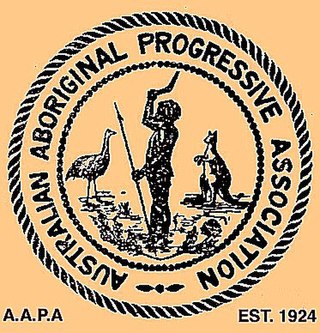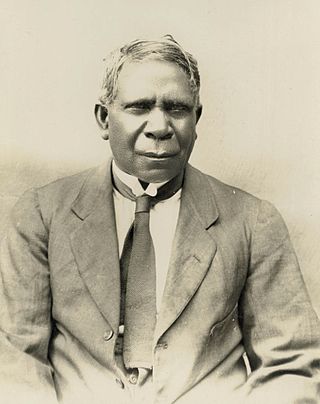
The Australian Abo Call, also known simply as Abo Call, was the first Aboriginal-focused publication printed in Australia, with all issues published in 1938.

The Australian Abo Call, also known simply as Abo Call, was the first Aboriginal-focused publication printed in Australia, with all issues published in 1938.
There was a total of six issues of The Australian Abo Call, all published between April and September 1938. [1] It was the first publication in Australia focused solely on Aboriginal issues and politics. [2] [3]
The paper was written and edited by John (Jack) Patten, who co-founded of the Aborigines Progressive Association (APA) in 1937, and featured news gathered by Patten on his travels through eastern Australia, as well as from correspondents nationwide. The newspaper's tagline was "The Voice of the Aborigines". [3]
William Ferguson, who co-founded the APA with Patten, was opposed to the publication of the Abo Call on the grounds that he believed it was a mouthpiece for its right-wing financial backers P. R. Stephensen and William John Miles. Ferguson also considered the newspaper's title to be insulting towards Aborigines. [lower-alpha 1]
Stephensen was known as a writer and publisher, and was honorary secretary of the Aboriginal Citizenship Committee, a support group of the APA, [3] but was also known for turning to pro-Fascist, anti-Semitic, and anti-Communist views in his magazine The Publicist. which he founded in 1936. [4]
Abo Call closed down after six months of publication, due to lack of funds.
Abo Call is available online through Trove, a service hosted at the National Library of Australia which allows access to historic Australian periodicals and newspapers. [5]
The State Library of New South Wales holds the six issues that were published, among Percy Reginald Stephensen's papers. [6] [7]
Marcia Langton later wrote that she and the other founders of the monthly paper Koori Bina at Black Women's Action in 1976 had been inspired by Abo Call. [8] [9]

Roberta "Bobbi" Sykes was an Australian poet and author. She was a lifelong campaigner for Indigenous land rights, as well as human rights and women's rights.
NAIDOC Week is an Australian observance lasting from the first Sunday in July until the following Sunday. The acronym NAIDOC stands for National Aborigines' and Islanders' Day Observance Committee. NAIDOC Week has its roots in the 1938 Day of Mourning, becoming a week-long event in 1975.

The Day of Mourning was a protest held by Aboriginal Australians on 26 January 1938, the 150th anniversary of the arrival of the First Fleet, which marked the beginning of the colonisation of Australia. It was declared to be a protest of 150 years of callous treatment and purposefully coincided with Australia Day celebrations. Day of Mourning protests have been held on Australia Day ever since 1938, though protests sharing its aims on this day are more commonly held under the names Invasion Day or Survival Day.

Pearl Mary "Gambanyi" Gibbs was an Indigenous Australian activist, and the most prominent female activist within the Aboriginal movement in the early 20th century. She was a member of the Aborigines Progressive Association (APA), and was involved with various protest events such as the 1938 Day of Mourning. She has strong associations with activists Jessie Street and Faith Bandler.
The Australian colonies and in the nineteenth century created offices involved in dealing with indigenous people in the jurisdictions.

Marcia Lynne Langton is an Aboriginal Australian writer and academic. As of 2022 she is the Redmond Barry Distinguished Professor at the Melbourne School of Population and Global Health, University of Melbourne. Langton is known for her activism in the Indigenous rights arena.
John Thomas Patten was an Aboriginal Australian civil rights activist and journalist.

The Aborigines Progressive Association (APA) was an Aboriginal Australian rights organisation in New South Wales that was founded and run by William Ferguson and Jack Patten from 1937 to 1944, and was then revived from 1963 until around 1970 by Herbert Groves.

Cummeragunja Reserve or Cummeragunja Station, alternatively spelt Coomeroogunja, Coomeragunja, Cumeroogunga and Cummerguja, was a settlement on the New South Wales side of the Murray River, on the Victorian border near Barmah. It was also referred to as Cumeroogunga Mission, although it was not run by missionaries. The people were mostly Yorta Yorta.

Percy Reginald Stephensen was an Australian writer, publisher and political activist, first aligned with communism and later shifting support towards far-right politics. He was the co-founder of the fascist Australia First Movement, alongside businessman William Miles, and he was the author of The Foundations of Culture in Australia.
The Aboriginal Advancement League was founded in 1957 as the Victorian Aborigines Advancement League (VAAL), is the oldest Aboriginal rights organisation in Australia still in operation. Its precursor organisations were the Australian Aborigines League and Save the Aborigines Committee, and it was also formerly known as Aborigines Advancement League (Victoria), and just Aborigines Advancement League.

William Ferguson was an Aboriginal Australian leader.
William Townsend Onus Jnr was an Aboriginal Australian political activist, designer, and showman, also known for his boomerang-throwing skills. He was father of artist Lin Onus.

The Australian Aboriginal Progressive Association (AAPA) was an early Indigenous Australian organisation focused on Aboriginal rights, founded in 1924 by Fred Maynard and based in Sydney, New South Wales (NSW). It ceased operations in 1927. The AAPA is known as the first Aboriginal activist group in Australia, with its membership roster peaking at over 600 members, with 13 branches and 4 sub-branches in NSW.

Indigenous Australian literature is the fiction, plays, poems, essays and other works authored by Aboriginal and Torres Strait Islander people of Australia.

Maloga Aboriginal Mission Station also known as Maloga Mission or Mologa Mission was established about 15 miles (24 km) from the township of Moama, on the banks of the Murray River in New South Wales, Australia. It was on the edge of an extensive forest reserve. Maloga Mission was a private venture established by Daniel Matthews, a Christian missionary and school teacher, and his brother William. The mission station operated intermittently in 1874, becoming permanent in 1876. The Mission closed in 1888, after dissatisfied residents moved about 5 miles (8 km) upriver to Cummeragunja Reserve, with all of the buildings being re-built there.

The Australian Hall is a heritage-listed community building located at 150–152 Elizabeth Street, in the Sydney central business district, in the City of Sydney local government area of New South Wales, Australia. It was the site of the Day of Mourning protests by Aboriginal Australians on 26 January 1938. It was also known as the Cyprus–Hellene Club until 1998. The property is owned by the Indigenous Land Corporation, a statutory corporation of the Australian Government. It was added to the Australian National Heritage List on 20 May 2008 and was added to the New South Wales State Heritage Register on 2 April 1999.
Dawn was an Australian magazine created by the New South Wales Aborigines Welfare Board and aimed at Aboriginal Australians. It ran monthly from January 1952 until December 1968. Two issues were published in 1969, before the disbanding of the Aboriginal Welfare Board led to the publication ceasing.
William John Miles was an Australian businessman and far-right political activist.
This article was published in hardcopy in Australian Dictionary of Biography, Volume 10, (Melbourne University Press), 1986
{{cite book}}: |website= ignored (help)